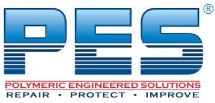Section 1: Identification of Substance/Preparation and Company
1.1 Product Identifier
PESCHEM 574 FASTFILL PLUG
1.2 Relevant Identified Uses of the Substance or Mixture and Uses Advised Against
Cementitious water based screed
1.3 Details of the Supplier of the Safety Data Sheet
5401 Hwy 21 West, Bryan, TX 77803
Tel: (979)779-8700Email: pes1@pes-solutions.com
1.4 Emergency Telephone Number
Chemtrec – 800-424-9300 (24 hrs)
Section 2: Hazards Identification
2.1 Classification of the Substance or Mixture
Classification in Accordance with the Dangerous Preparations Directive 1999/45/EC
Xi; R37/38 — Irritating to respiratory system and skin
R41 — Risk of serious damage to eyes
R43 — May cause sensitization by skin contact
Muta. 3; R68 — Possible risk of irreversible effects
Repr. 2; R62 — Possible risk of impaired fertility
R52/53 — Harmful to aquatic organisms, may cause long-term adverse effects in the aquatic environment
Classification in accordance with the Classification Labeling and Packaging Regulation EC (no) 1272/2008
H315 — Causes skin irritation
H317 — May cause an allergic skin reaction
H318 — Causes serious eye damage
STOT SE 3 H335 — May cause respiratory irritation
Pictograms:
 Signal Word:
Signal Word:
DANGER
Hazardous Statements:
H315 — Causes skin irritation
H317 — May cause an allergic skin reaction
H318 — Causes serious eye damage
STOT SE 3 H335 — May cause respiratory irritation
Precaution Statements:
P261: Avoid breathing dust/fume/gas/mist/vapors/spray
P280: Wear protective gloves/protective clothing/eye protection/face protection
P302+P352: If on skin: wash with plenty of soap and water
P304+P340: Remove victim to fresh air and keep at rest in a position comfortable for breathing
P305+P351+P338: IF IN EYES: Rinse cautiously with water for several minutes. Remove contact lenses.
P310: Immediately call a doctor
P321: Specific treatment (see section 4)
P333+P313: If skin irritation or rash occurs: Get medical advice/attentionP363: Wash contaminated clothing before reuse
P403: Store in well ventilated place
P501: Dispose of contents/container as hazardous waste
2.3 Other hazards
No significant hazard
Section 3: Composition/Information on Ingredients
3.1 Substances
 3.2 Mixtures
3.2 Mixtures
No significant hazard
Section 4: First Aid Measures
4.1 Description of First Aid Measures
Summon immediate medical assistance after contact with skin, eyes, inhalation or ingestion
Eye: Flush eyes with plenty of running water for 15 minutes, whilst gently holding the eyelids open. Seek immediate medical attention.
Skin: Remove product and contaminated clothing and wash area with water, seek medical advice.
Ingestion: Drink plenty of water, DO NOT INDUCE VOMITING. Seek medical attention immediately.
Inhalation: Remove patient to fresh air. If breathing has stopped give assisted respiration. Prevent aspiration of vomit. Turn victims head to one side. Seek medical advice.
4.2 Most Important Symptoms and Effects, Both Acute and Delayed
Eye Contact: Sign/Symptoms may cause irritation to eyes
Skin Contact: Sign/Symptoms may cause irritation to skin
Inhalation: Sign/Symptoms may cause irritation to respiratory system
Ingestion: Sign/Symptoms may cause nausea and vomiting
4.3 Indication of Any Immediate Medical Attention and Special Treatments Needed
Symptomatic treatment as required
Section 5: Fire Fighting Measures
5.1 Extinguishing Media
This product is not flammable
5.2 Special Hazards Arising from the Substance or Mixture
None
5.3 Advice for Fire Fighters
Wear Self-contained breathing apparatus, rubber boots, gloves and body suit
Section 6: Accidental Release Measures
6.1 Personal Precautions, Protective Equipment and Emergency Procedures
Avoid raising dust. Ensure adequate ventilation of the working area. Wear protective equipment.
6.2 Environmental Precautions
Prevent entry into sewers and watercourses. If product enters sewers or watercourses, inform the appropriate environmental authorities.
6.3 Methods and Materials for Containment and Clearing Up
Clean up using a vacuum cleaner.
6.4 References to Other Sections
Refer to section 5, 8 and 13 for protective Measures and Disposal.
Section 7: Handling and Storage
7.1 Precautions for Safe Handling
Avoid contact with skin, eyes and clothing. Handle in well ventilated area. Avoid breathing dust. Wash hands after contact.
7.2 Conditions for Safe Storage, Including Any Incompatibilites
Keep container tightly closed in a cool, well ventilated area.
7.3 Specific End Use(s)
No industrial or sector specific guidance available.
Section 8: Exposure Controls/Personal Protection
8.1 Control Parameters
 8.2 Exposure Controls
8.2 Exposure Controls
Engineering Controls: Adequate ventilation should be provided so that exposure limits are not exceeded.
Respiratory: Avoid Breathing Vapors or dust; Select and use respiratory protection. Suggested filter type AP2.
Hand Protection: Wear suitable chemical resistant gloves.
Skin Protection: Avoid Skin Contact; use disposable coveralls
Eye Protection: Avoid Eye Contact; use safety goggles meeting the requirements of BS EN166 3, when handling this product
Environmental Exposure Controls: Take suitable measures to prevent entry into drains, sewers and watercourses.
Section 9: Physical/Chemical Properties
9.1 Information on Basic Physical and Chemical Properties
Appearance: Grey Powder
Odor: Characteristic
Odor thresholds: No data
PH: No data
Melting Point: No data
Boiling Point/Range: No data
Flash Point: No data
Evaporation Rate: No data
Flammability: Not applicable
Upper/lower flammability limits: No data
Vapor Pressure: No data
Vapor Density: No data
Relative Density: No data
Solubility in water: No data
Solubility in other solvents: No data
Partition Coefficient: No data
Auto-ignition temperature: No data
Decomposition temperature: No data
Viscosity: No data
Explosive properties: Not classified as explosive
Oxidizing properties: Not classified as oxidizing
9.2 Other Information
None.
Section 10: Stability and Reactivity
10.1 Reactivity
Not considered to be a reactive product
10.2 Chemical Stability
Stable
10.3 Possibility of Hazardous Reactions
No significant hazard
10.4 Conditions to Avoid
Strong acids will produce exothermic reaction. Keep away from moisture.
10.5 Incompatible Materials
Strong acids.
10.6 Hazardous Decomposition Products
None
Section 11: Toxicological Information
11.1 Information on Toxicological Effects
This product has not bee tested. Judgements on the expected toxicity of this product have been made based upon consideration of its major components.

Section 12: Ecological Information
This product has not been tested. Judgements on the expected toxicity of this product have been made based upon consideration of its major components.
12.1 Toxicity
No data
12.2 Persistence and Degradability
No data
12.3 Bio-accumulative Potential
No data
12.4 Mobility in Soil
No data
12.5 Results of PBT and vPvB assessment
No data
12.6 Other Adverse Effects
No data
Section 13: Disposable Considerations
13.1 Waste Treatment Methods
In uncured state, dispose as chemical waste in accordance with local regulations. Waste from this product may present long term environmental hazards. Thus landfill sites must be considered less acceptable than incineration. In cured stated when mixed correctly with the base component, dispose as solid waste.
Section 14: Transport Information
General: Transport and labeling requirements will alter depending on the size of the packaging. Please refer to local transport regulations.
This product is not classified as dangerous for transport.
Section 15: Regulatory Information
15.1 Safety, health and environmental regulations/legislation specific for the substance or mixture
All components are listed as existing substances in Europe
All components are listed, or are exempt from listing on the TCSA Inventory
15.2 Chemical Safety Assessment
A chemical Safety Assessment has not been carried out for this product.
Section 16: Other Information
Revision information:
Reformatted in accordance with Regulation 453/2010 and Regulation 1272/2008.
List of Abbreviations used in this SDS:
CAS — Chemical Abstract Service
CLP — Classification, Labeling and Packaging Regulation (EC) no 1272/2008
DSD — Dangerous Substances Directive 67/548/EEC
DPD — Dangerous Preparations Directive 1999/45/ECEC — European Community/Commission
PBT — Persistent, Bio-accumulative and Toxic
REACH — Registration, Evaluation, Authorization and Restriction of Chemicals Regulation (EC) no 1907/2006
vPvB — very Persistent, very Bio-accumulative
References:
ECHA Classification and Labeling inventory
ECHA database of disseminated registration dossiers
Supplier’s Safety Data Sheets
Method used for classfication mixtures:
Ingredient based approaches
R Phrases and H Statements used in Section 3
R36 — Irritating to eyes
R36/38 — Irritating to eyes and skin
R37 — Irritating to respiratory system
R41 — Risk of serious damage to eyes
R43 — May cause sensitization by skin contact
R66 — Repeated exposure may cause skin dryness or cracking
H317 — May cause an allergic skin reaction
H318 — Causes serious eye damage
H335 — May cause respiratory irritation
Training requirements for workers
No special training requirements.



One Response to PES 574 Fastfill Plug